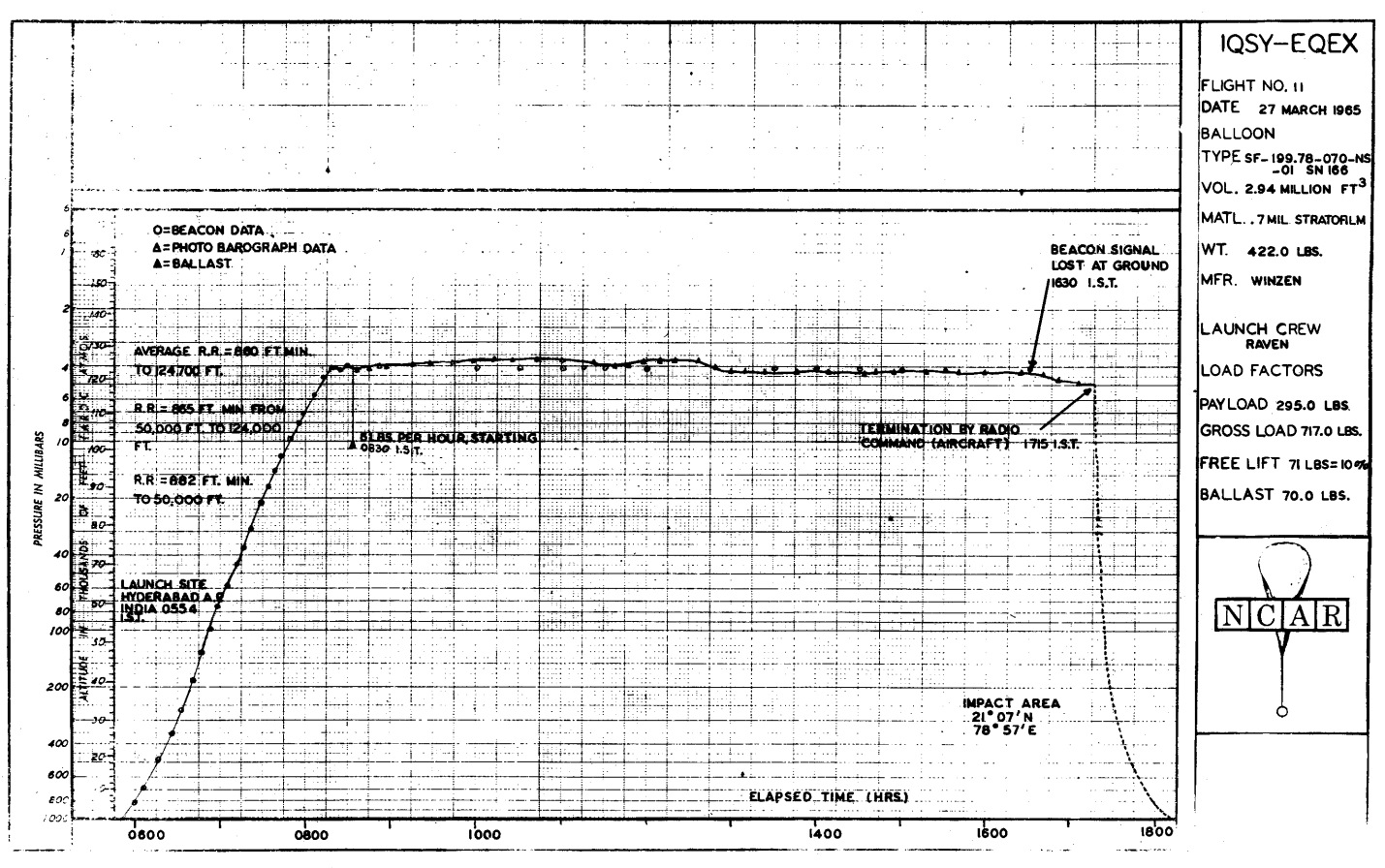Purpose of the flight and payload description
This flight was part of a balloon expedition to study cosmic rays in the vicinity of the equator during the International Quiet Sun Year (IQSY) organized and managed by the National Center for Atmospheric Research as a joint United States - India activity. The program was conducted in Hyderabad, India during the late winter and early spring of 1965.
The main experiment was composed by a large area nuclear emulsion stack mounted in an emulsion camera developed at the University of Minnesota (Waddington group). The objective was to investigate the very high charge nuclei of the primary cosmic radiation in much greater detail than has hitherto been possible. The use of the emulsion camera removed the uncertainties introduced by the ascent period of the flight, while the large area available permited the acquisition of statistically significant data.
A secondary load in this flight was a self-recording ion chamber also provided by University of Minnesota (Wrinckler group) aimed to obtain equator values for total ionization as part of complete latitude curve during the period of minimum solar activity.
The nuclear emulsion stack could not be positioned with a mass of metal above it. It was therefore necessary to suspend all other equipment below the sphere containing the emulsions. Attachment of a suitable impact cushion to the sphere was accomplished by first attaching a block of styrofoam shaped to fit the curvature of the sphere and placing the crush pad on the flat surface of the styrofoam block. A sun shade was constructed of corrugated paper and painted white. Small styrofoam blocks held the shade away from the sphere. Flight control instruments and the ballast supply were suspended 6 ft below the sphere on four 1/8-in. cables. A 6-ft length of bamboo held the antenna away from the ion chamber which was suspended 25 ft below the control instruments. The load was suspended from the balloon on a 28-ft parachute.
Details of the balloon flight

Balloon launched on: 3/27/1965 at 5:54 ist
Launch site: Osmania University Campus, Hyderabad, India
Balloon launched by: Raven Industries Inc.
Balloon manufacturer/size/composition: Zero Pressure Balloon Winzen 2.940.000 cuft (0.7 Mil. Stratofilm)
Balloon serial number: SF-199.78-070-NS-01 S/N 166
End of flight (L for landing time, W for last contact, otherwise termination time): 3/27/1965 at 17:15 ist
Balloon flight duration (F: time at float only, otherwise total flight time in d:days / h:hours or m:minutes - ):
Landing site: Payload impact at coordinates: 21º 07' N, 78º 57' E
Campaign: No Data IQSY-EQEX
Payload weight: 295 lbs
Overall weight: 717 lbs
The balloon was released at 5:54 local time on March 27, 1965. The sphere and control instruments were gently lifted free of the launch cart while the ion chamber was hand launched. The antenna was released by radio command at 1,500 ft. While ascending at an average rate of 860 ft/min, to 124,000 ft, the balloon first went east, then took a northerly track. A float duration of 8.75 hr took the balloon to the west of Nagpur where the flight was terminated by radio command from the aircraft at 17:15 local time.
The descent was rather fast with considerable oscillation which caused the control instruments to damage the top of the sphere. On several occasions, the ion chamber was observed to be near the top of the chute. The flight landed 9 mi west of the Nagpur airport. The aircraft crew hired a taxi to reach the village where the instruments were being held. Villagers followed recovery tag instructions and would not give up the instruments to Dr. Waddington, who offered to pay the reward on the spot. The instruments were recovered the following morning after police had assured the villagers that Dr. Waddington and pilot A. Tomnitz were actually the people who had sent the equipment aloft.
External references
- Ballooning Support for Cosmic-Ray Experiments NCAR Technical Note NCAR/TN-20, September 1966
15880If you consider this website interesting or useful, you can help me to keep it up and running with a small donation to cover the operational costs. Just the equivalent of the price of a cup of coffee helps a lot.

